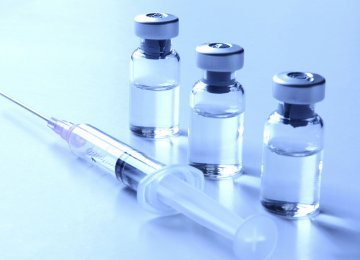19th April 2020 – Vaccines against the COVID-19 virus are the answer but we must proceed with caution.
A Blog by Dr David J Flavell PhD FRCPath
Charity & Scientific Director of Leukaemia Busters
19th April 2020
COVID-19 Vaccines – A Cautious Promise
I could almost hear a collective cheer go up around the biomedical research community when the UK’s Business Secretary, Alok Sharma announced new British led initiatives for vaccine development against the SARS-CoV-2 virus at the No 10 briefing last Friday. Two groups, one led by Professor Sarah Gilbert in Oxford and the other by Professor Robin Shattock at Imperial College in London will spearhead the drive in Britain to develop a vaccine using two different approaches.
UK COVID-19 Vaccine Task Force
Additionally, the UK is to set up a COVID-19 vaccine task force that will be instrumental in forging collaborations between industry, academic researchers and charities to speed up the vaccine discovery and development processes with tens of millions of pounds of tax payers money injected into the whole enterprise.
It will undoubtedly be money well spent. It is widely agreed that the only realistic long term solution to the COVID-19 pandemic is an effective and widely available vaccine, so the race is now on and the UK are now at the front of the pack with this.
With over 80 SARS-CoV-2 vaccine candidates in development around the world the push to get there first has become intense and, as warned by Professor Sir Patrick Vallance at yesterday’s briefing, the likelihood that many, if not most of these, will fail is high. The majority of new treatments including vaccines for human ailments often fall at the last hurdle usually for reasons of safety or efficacy.
UK previous track record on Vaccines
But that said let me inject some optimism in saying that I feel strongly that at least one of the 80 or so candidate vaccines in development around the globe will win through and that there’s every chance that it will be one of our own in the UK. We certainly have the know-how to achieve this and a track record that started over two hundred years ago with the British physician Dr Edward Jenner and the worlds first vaccine that happened to be against smallpox.
Whole “living” viral vector vaccine platform
Appropriately enough, Sarah Gilbert’s group work out of the Jenner Institute in Oxford. Professor Gilbert’s vaccine platform is based on a chimpanzee adenovirus that is non-pathogenic in humans (that is, it doesn’t cause illness) but has been genetically engineered to deliver the DNA encoding for the SARS-CoV-2 spike protein to cells of the person receiving the vaccine.
The spike protein you may remember from one of my previous blog “Vaccinating the Herd“ sticks out from the surface of the virus giving it the characteristic crown-like appearance and importantly is also the means by which coronavirus enters and infects the cells in the nose, throat and lungs.
The DNA delivered by the chimpanzee adenovirus contains the blueprint to build the spike protein which is then “read” inside the vaccinated persons own cells causing them to manufacture quantities of the spike protein which in turn generates an immune response against the spike protein. This approach has been highly successful in animal models of Middle East Respiratory Syndrome (MERS) virus and shows a high degree of promise
Nucleic acid vaccine (RNA) platform
Professor Shattock’s vaccine is different because it doesn’t use a viral vector to deliver the genetic material that encodes for the spike protein of the SARS-CoV-2 virus. Instead it is comprised of a self-replicating form of RNA that carries all the instructions to the vaccinated individuals muscle cells to make the viruses spike protein which just like the Gilbert system provokes an immune response against this viral protein. This particular platform is not quite so far along in development for COVID-19 as is the Gilbert approach and we shall see, probably fairly quickly now, just how this vaccine platform shapes up.
Important points to consider
The vaccine route is the surest way to guarantee that the COVID-19 problem will be solved once and for all. But there are two important things to realise.
- The first is that vaccine development normally has a time scale of between 5 and 10 years from conception to administration to people. That is because there are many practical hurdles to overcome along the way, things that simply take the time to do and can’t be rushed.
- There’s firstly testing in animals for safety and effectiveness where groups of experimental animals are vaccinated and then some weeks later exposed to the pathogen to determine if they are immune and to establish what are the antibodies and other immune markers that confer immunity following vaccination. These are called pre-clinical studies and can take up to a year or longer to complete.
- If this phase of development is successful then the next thing to do is manufacture quantities of the vaccine to a clinical standard called cGMP for testing in normal volunteers for safety and efficacy.
Think about that, how do you test for vaccine efficacy in people?
-
- The only sure way is to vaccinate and then some weeks later deliberately challenge them with the COVID-19 virus, sit back and see if they develop the illness.
- You could of course also look for antibodies in the blood of vaccinated individuals that are against the virus but the presence antibodies doesn’t always accurately predict if that the person is fully immune particularly if those antibodies are against the wrong part of the virus.
Can you therefore see the problem with this when it comes to COVID-19?
-
- What happens if your vaccine under test is only partially or even completely non-effective, then you have put all your vaccinated volunteers at risk when you challenge them with a virus that causes a potentially fatal disease. There are no easy solutions in this very serious game.
- The second issue is this. In the current coronavirus pandemic crisis where there is a rush for a vaccine there may be the temptation to take short-cuts and omit some of the testing procedures normally used that are there for a good reason. This could be dangerous for a whole host of reasons, not least of all the danger that the vaccine stimulates the wrong type of immune response that turns out to be damaging or causes the virus to become even more virulent.
-
- There have been instances of vaccines developed in the past against other coronaviruses responsible for the original SARS outbreak in 2002/03 and Middle East Respiratory Syndrome (MERS) in 2009 that in experimental animal models have made the severity of disease worse, with increased lung damage due to the wrong type of immune response or because the antibodies that were produced following vaccination rather than neutralising the virus actually enhanced their infectivity for the host cells.
These are just two of the several reasons why vaccine development and testing is so important before any mass vaccination programme ensues. I hope that you are able to see more clearly now just some of the problems involved in vaccine development and why the time scales are so extended.
That said, I am still highly optimistic that the major global drive now on will eventually deliver an effective and safe vaccine for COVID-19 but that it will take longer than most people are anticipating for. It would be a wonderful accolade for the ingenuity and skill of our home grown scientists currently working feverishly towards this goal if the successful vaccine were to originate from these islands.
I wish both the Gilbert (Oxford) and Shattock (Imperial College, London) vaccine groups every success in their endeavours which stand as good a chance, if not better, than any of the others to succeed.
To read our other blogs click here.
For an up to date on our COVID-19 blog please follow us on Twitter:



